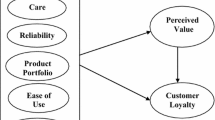Abstract
While many electronic commerce (e-commerce) systems have been successfully adopted in businesses across a number of different industries, a significant number have failed, especially in small and medium enterprises (SMEs). It is therefore necessary to explore new methods to describe and measure e-commerce success from a business perspective.
Using the fifteen critical success factors (CSFs) obtained from previous works as a foundation, this continuing research explored an EBS Management Model categorised into five components including Marketing, Management Support & Customer Acceptance, Web Site Effectiveness & Cost, Managing Change, and Knowledge & Skills. Further research is needed to determine the weighting of these CSFs and components as a yardstick so that this EBS Management Model, as an established practical model, can be adopted by business managers for the pursuit of e-commerce success, and assist service industry SMEs in effectively adopting e-commerce systems using a business-focused approach.





Similar content being viewed by others
References
Benou, P., & Vassilakis, C. (2010). The conceptual model of context for mobile commerce applications. Electronic Commerce Research, 10(2), 139–165.
Chen, M. Y., & Teng, C. I. (2013). A comprehensive model of the effects of online store image on purchase intention in an e-commerce environment? Electronic Commerce Research, 13(1), 1–23.
Cagnina, M. R., & Poian, M. (2008). CellTrust: a reputation model for C2C commerce. Electronic Commerce Research, 8(4), 193–216.
Churchill, G. A., & Lacobucci, D. (2002). Marketing research methodological foundation. Thomson Learning, USA: South-Western.
Field, A. (2005). Chap. 15: factor analysis on SPSS, discovering statistics using SPSS. London: Sage.
Field, A. (2005). Chap. 15: Reliability analysis on SPSS, discovering statistics using SPSS. Sage, London.
Gide, E., & Wu, M. X. (2007). A study to establish e-commerce business satisfaction model to measure e-commerce success in SMEs. International Journal of Electronic Customer Relationship Management, 1(3), 307–325.
Garson, D. (2007). Scales and standard measures [online]. Viewed, 24 Oct 2007. http://www2.chass.ncsu.edu/garson/pa765/standard.htm.
Garson, G. D. (2008). Reliability analysis [online]. Viewed 30 May 2008. http://www2.chass.ncsu.edu/garson/PA765/reliab.htm.
Hanover (2012). Reliability analysis [online]. Viewed 12 December http://psych.hanover.edu/classes/ResearchMethods/Assignments/reliability-1.html.
Kitchenham, B., & Pfieeger, S. L. (2002). Principles of survey research. Part 4. Questionnaire evaluation. Software Engineering Notes, 27(3), 20–23.
Koutsabasis, P., Stavrakis, M., & Viorres, N. (2008). A descriptive reference framework for the personalisation of e-business applications. Electronic Commerce Research, 8(3), 173–192.
Lehdonvirta, V. (2009). Virtual item sales as a revenue model: identifying attributes that drive purchase decisions. Electronic Commerce Research, 9, 1–2, pp.97-113.
Lu, J., Wang, L. Z., Yu, C. S., & Wu, J. Y. (2009). E-auction web assessment model in China. Electronic Commerce Research, 9(3), 149–172.
Malhotra, N., Hall, J., Shaw, M., & Oppenheim, P. (2006). Marketing research: an applied orientation. Australia: Pearson.
PSU (2012). SPSS syntax. Viewed 12 December [online]. http://www.personal.psu.edu/faculty/k/r/krm10/reliability.
Schwab, A. J. (2002). Principal component analysis: additional topic [online]. Viewed 25 May 2008. http://www.utexas.edu/courses/schwab/sw388r7/SolvingProblems/PrincipalComponentAnalysis_Outliers_Validation_Reliability.ppt.
SPSS (1998). Survey research using SPSS. Viewed 20 March 2006 [online]. www.ts.vcu.edu/manuals/spss/guides/Survey%20Research.pdf.
Wu, M. X., Jewell, R., & Gide, E. (2012). An eyeball diagram: illustrating the common CSFs in e-commerce business satisfaction for successful adoption of e-commerce systems by SMEs. International Journal of Electronic Customer Relationship Management, 6(2), 169–192.
Yaffee, R. A. (2003). Common correlation and reliability analysis with SPSS for Windows [online]. Viewed 2008. http://www.nyu.edu/its/statistics/Docs/correlate.html.
Zikmund, W. G., & Babin, B. J. (2007). Exploring marketing research. USA: Thomson Higher Education.
Zikmund, W. G., Ward, S., Lowe, B., & Winzar, H. (2007). Marketing research. Australia: Nelson Australia.
Hair, J. F., Anderson, R. E., Tatham, R. L., & Black, W. C. (1998). Multivariate Data Analysis. New Jersey: Prentice Hall.
Author information
Authors and Affiliations
Corresponding author
Rights and permissions
About this article
Cite this article
Wu, M., Gide, E. & Jewell, R. The EBS management model: an effective measure of e-commerce satisfaction in SMEs in the service industry from a management perspective. Electron Commer Res 14, 71–86 (2014). https://doi.org/10.1007/s10660-013-9127-y
Published:
Issue Date:
DOI: https://doi.org/10.1007/s10660-013-9127-y



